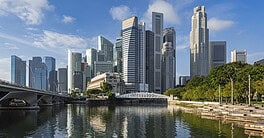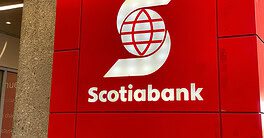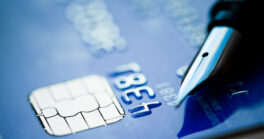Cash-rich Gulf state, bolstered by a healthy banking sector, is taking steps to reduce dependence on petroleum and motivate entrepreneurs.

Notwithstanding the low oil prices of recent years, Kuwait’s banking system remains among the strongest in the Middle East. In 2015 and 2016, Kuwait’s economy grew by 2% and 2.5%, according to research from the Union of Arab Banks (UAB), while aggregated assets of Kuwaiti banks grew by 5.7% and 1%, respectively.
“Despite the challenging economic and financial environment amid low and volatile oil prices, the Kuwaiti banking sector has managed to maintain its stability and soundness and has achieved good growth rates,” says the UAB report. “Kuwaiti banks continued to maintain high capital levels, given the central bank’s strong focus on ensuring robust capital adequacy and financial stability.”
Since 2014, all indicators are on the rise. Total bank assets stood at $209 billion at the end of the third quarter, increasing 13.8% since 2014. Over the same period, deposits and equity recorded boosts of 11% and 10%.
The capital-adequacy ratio of the nation’s banks stood at 16.9% in 2014 and rose steadily over the years to reach 18.3% in 2017’s second quarter—well above the central bank’s required 13%.
“Kuwait’s banking sector is very strong in terms of capital, asset quality and profitability,” says Eduardo Eguren, Burgan Bank Group CEO. “All banks in Kuwait are well managed and enjoy the support of a conservative regulator.”
According to the latest assessment from the International Monetary Fund (IMF), Kuwait’s banks are “resilient to various stress-test scenarios, including protracted credit, liquidity and market shocks.” The banking sector is also the main driver of corporate earnings growth. According to Boursa Kuwait’s 2016 annual report, only 13 out of 196 listed companies are banks, but they accounted for 46% of total market capitalization.
With a population only slightly above four million, Kuwait is a small country with an easily saturated local market; but its banks have managed to expand into fast-growth markets in the MENA region and further.
Fiscal Adjustments
The public sector, which employs more than 75% of the local population, is still able to largely dominate the economy—a situation not uncommon in the region. The IMF, typically, is encouraging Kuwait to boost its private sector to balance that out: “Moving from a public-sector-led growth model to one driven by the private sector requires creating incentives for risk taking and entrepreneurship, fostering productivity and competitiveness, and encouraging private initiative and investment.”
The country is gradually implementing structural reforms, including a fiscal adjustment plan and subsidy reductions. The government plans on introducing a value-added tax (VAT).
For the IMF, however, this is not quite enough: “Notwithstanding the impact of the tax reforms and spending restraint … the government’s non-oil balance is projected to fall well short of levels needed to ensure equally high living standards for future generations,” concludes the international institution in its most recent mission report on Kuwait, published in November. “Additional fiscal consolidation is therefore needed to close this gap.” The IMF calls for lower wages and further reductions in subsidies.
However, such unpopular measures will not come without backlash. The entire government resigned in October, largely over widespread opposition to austerity measures, including some taxes regarded as extreme, and the raising of healthcare and fuel prices.
IMF Prescriptions
Hydrocarbons account today for 90% of Kuwait’s government income and more than 50% of GDP but, as the oil sector faces growing challenges, Kuwait is taking steps to diversify its economy and create a business environment that encourages private investment. A new law increasing the percentage of Kuwaitis working in the private sector is expected to be issued in the first quarter of 2018.
Reforms that were begun in 2010 are starting to show positive effects, with an expected non-oil growth rate of 3% for 2017, according to the IMF. This figure should rise to between 3.5% and 4% by 2019.
Capital spending remains the main driver of growth. Kuwait’s Vision 2035 plan aims to transform the country into a financial hub with large infrastructure investments in all sectors. The plan includes a 300% increase in foreign direct investment, pumping more than $1.3 billion into such new sectors of the economy as information technology and renewable energy.
“The banks are strong and well capitalized,” says Burgan Bank’s Eguren. “They are ready to finance projects, be those in the public or private sectors.” The banks’ business culture, however, still has a fair margin for progress when compared to more established financial hubs.
A third of the spending is supposed to come from public-private partnerships. However, few have materialized so far, and international observers argue that the country still needs legal reforms to make the business environment more attractive to private investors.
“Things take time in Kuwait. Everything is a bit slow. The implementation and activation of credit lines, for example, takes time,” says Radhouane Elloumi, senior corporate relationship manager at Kuwait Finance House, Kuwait’s main Islamic bank. “This has a direct impact on business. For large operations, mobilizing teams in time to win new markets is sometimes difficult.”
Nurturing New Growth
Government efforts to support entrepreneurship have included allocation of $7 billion to the Kuwait National Fund for SMEs in 2013, promoting small and midsize enterprises, many of which leverage the Internet or digital technologies in some way.

“Technology is rapidly transforming the banking sector. The opportunity for growth of online goods and service providers, as well as mobile transactions, is very high,” says Rita Makhoul, managing editor at Arabnet, a regional start-up network that entered the Kuwaiti market in 2016. “Kuwait’s banks are looking to fuel their success by investing in the digital economy and new technologies, including contactless payments, blockchain and e-wallets.”
The first Kuwaiti start-up success stories include Talabat, a food-delivery website and application that sold to the German company Rocket Internet for $170 million in 2015; and Carriage, a similar start-up bought for $100 million by another German company, Delivery Hero, in 2017, only 15 months after its launch.
Still, in the current crowded and fast-changing environment, it takes more than passion and cash to create a viable ongoing business. “Between the years 2013 and 2016, the country registered only four investment deals. The country also has notable gaps in angel networks and seed funds, and provides only early-stage funding,” observes Makhoul. “The start-up investment sector in Kuwait is still far behind in the race with its GCC rivals.”
Kuwaiti Bonds Unbound
The Sovereign Wealth Fund Institute’s 2017 estimates show that the Kuwait Investment Authority is the world’s fourth-largest sovereign wealth fund, with $524 billion (480% of GDP). Most of its assets are held abroad and have grown by 34% over the past five years according to Kuwaiti Finance minister Anas Al-Saleh.
It seems that the country could finance most of its needs itself. However, Kuwait has chosen to open up to international markets and rely on debt to finance its deficit. Kuwait, whose economy relies almost exclusively on hydrocarbons, recorded its first budget deficit in 2015 due to the collapse in oil prices. The deficit grew to 16.5% of GDP in 2016.
Last March, the Kuwaiti government sold $8 billion in international debt: $3.5 billion of five-year bonds and $4.5 billion of 10-year bills. For this first issuance, Kuwait showed a prudent approach with tightly priced bonds.
In September, however, the law allowing the Ministry of Finance to issue debt expired, bringing new issuances to a halt. Less than a year after its first debt issuance, Kuwait’s parliament approved a bill allowing the government to raise the borrowing ceiling from $30 billion to $83 billion and sell sovereign bonds out to 30 years.
For GF’s interview with NBK-Kuwait CEO Salah Al-Fulaij, click here.
For GF’s interview with Al Ahli Bank of Kuwait CEO Michel Accad, click here.
For the sidebar on Revamping Kuwait’s Stock Exchange, click here.
GFmag.com Data Summary: Kuwait
|
Central Bank: Central Bank of Kuwait |
|||
|
International Reserves |
US$ 33.9 billion |
||
|
Gross Domestic Product (GDP) |
US$ 118.3 billion* |
||
|
Real GDP Growth |
2015 |
2016 |
2017 |
|
GDP Per Capita—Current Prices |
US$ 27,756* |
US$ 26,145* |
US$ 28,756* |
|
GDP—Composition By Sector* |
agriculture: |
industry: |
services: |
|
Inflation |
2015 |
2016 |
2017 |
|
Public Debt (general government |
2015 |
2016 |
2017 |
|
Government Bond Ratings (foreign currency) |
Standard & Poor’s |
Moody’s |
Moody’s Outlook |
|
FDI Inflows |
2014 |
2015 |
2016 |
* Estimates Source: GFMag.com Country Economic Reports, IMF, UNCTAD



